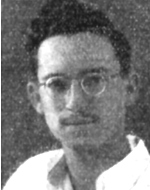Segal, Yair
Son of Pnina was born on February 12, 1929 in Jerusalem, and moved to Tel Aviv with his family, where he studied for eight years at the Bilu elementary school and four years at the Herzliya Gymnasium “He said. His parents were about to be sent to study in the United States, but he refused to leave the country because he felt the danger of war looming over her. One of his close friends said that Yair did not join the Haganah when they reached the Gymnasium, and when he reached the end of his year of service, he volunteered for the Nutras, but eventually went with them to the Palmach, where he worked for a farmer in Nahalal. Yair continued to work with his team in Mishmar Hayam, Kfar Masaryk and Ramat Yohanan, and because of various conflicts, the group returned to the city after only a year and a quarter in the Palmach. Shortly after he began working as a clerk in the telegraph company, the War of Independence began and Yair enlisted and served in a heavy weapons company in the Givati Brigade. He participated in guarding the positions of the Tel Aviv suburbs, accompanied by convoys, battles and reprisals in the vicinity, the JNF House near Beit Dagon, Bat Yam, Yazur. In Latrun he wanted to be with the fighters in the first armored vehicles, but for lack of space remained in the second column and thus saved from the fate of the casualties in the first column. Although he did his duty with all the zeal and devotion, he remained very sensitive to human life, even an enemy, and when he saw the Arab dead in one of the operations around the city, the mirror was a long nightmare. Every news of the fall of a friend shocked him even in the midst of the storm of battle, and when one of his friends was cut off at the hospital, they did not let his Lev go to visit him: “How can I go to him and have two hands?” He also could not bear the parents’ anxiety about his fate, and reassured them that he was busy guarding the Tsrifin. Yair completed a paramedics course and later served as a company paramedic in battles near Ashdod and the south. His unit clung to Hill 69 east of the coastal road to block the movement of the Egyptians. The hill was captured on June 8, 1948, and the force began to barricade itself. On Tuesday, June 10, 1948, the Egyptians shelled the site and then attacked it with armored vehicles, causing enemy casualties, the collapse of the positions and the damage to the weapons. Another fighter was killed, and when he stopped running and went to help a wounded friend, he was considered missing until his body was found on August 31, 1950. He was laid to rest at the Nachlat Yitzhak military cemetery.
